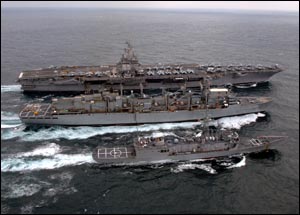 |
Military Sealift Command Combat Logistics Force |
|||||||||
|
||||||||||
|
Combat Logistics Force
The 34 ships of Military Sealift Command's Combat Logistics Force are the supply lines to U.S. Navy ships at sea. These ships provide virtually everything that Navy ships need, including fuel, food, ordnance, spare parts, mail and other supplies. CLF ships enable the Navy fleet to remain at sea, on station and combat ready for extended periods of time. All CLF ships are government owned and crewed by civil service mariners. Some of the ships also have a small contingent of Navy personnel aboard for operations support, supply coordination and helicopter operations. Fleet Replenishment Oilers Fifteen fleet replenishment oilers, the largest subset of Combat Logistics Force ships, provide fuel to deployed Navy ships at sea, as well as to their assigned aircraft. Oilers and the ships they refuel sail side by side as fuel hoses are extended across guide wires. Underway replenishment of fuel dramatically extends the time a Navy battle group can remain at sea.
Ammunition Ships One ammunition ship supplies ordnance to Navy combatants at sea, providing service through a combination of alongside transfers and vertical replenishment lifts via helicopter.
Fast Combat Support Ships MSC's four fast combat support ships provide one-stop shopping to the fleet for fuel, ammunition, food and other cargo. These ships are especially valuable because of their speed and ability to carry all the essentials to replenish Navy ships at sea. MSC's fast combat support ships, formerly sailor-operated, transferred to MSC for civil service crewing beginning in 2001. Dry Cargo/Ammunition Ships
Eleven of MSC's dry cargo/ammunition ships are dedicated to the Combat Logistics Force. These ships are able to deliver ammunition, provisions, stores, spare parts, potable water and petroleum products to the Navy's carrier strike groups and other naval forces worldwide. Designed to operate for extended periods at sea, the Lewis and Clark-class ships have improved cargo handling equipment that increases efficiency and makes the ships more cost effective to operate and maintain. All the Lewis and Clark-class ships are named after great American pioneers.
Commercial Helicopters MSC's support to the fleet took a major step forward in 2000 when, for the first time, a commercial helicopter detachment provided logistics and vertical replenishment services aboard two MSC combat stores ships deployed to the Mediterranean Sea and the Persian Gulf. This mission was previously done only by Navy helicopters. The service was so successful that it was expanded in 2006 to include detachments based out of Guam. With the addition of dry cargo/ammunition ships to MSC's fleet in 2006, commercial helicopters began operating with this new platform. The commercial helicopter detachments dedicated to logistics and vertical replenishment missions free up Navy active duty sailors and aircraft to focus on the critical warfighting missions for which they were trained.
Combat Logistics Force: Past, Present And Future The Combat Logistics Force began as the Naval Fleet Auxiliary Force in 1972 with the transfer of Navy fleet oiler USS Taluga to MSC operation after a series of tests proved that civil service crews could operate the Navy's fleet support ships as effectively and more cost efficiently than Navy sailors. MSC now provides all of the Navy's combat logistics services to the fleet. In the years to come, MSC's Combat Logistics Force will continue to be a vital, cost- effective and innovative element of the U.S. Navy, actively supporting the Navy's combat readiness and ability to project a powerful forward presence. |
| Privacy Policy | Accessibility | Advanced Search | Site Index | Help | FOIA | IG Hotline |
CIVMAR support: 1-800-793-5784 • Marine Employment Opportunities: 1-877-JOBS-MSC (562-7672) • Email: webmaster@msc.navy.mil





